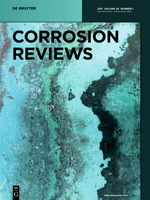
CORROSION REVIEWS
Scope & Guideline
Fostering Interdisciplinary Understanding of Corrosion
Introduction
Aims and Scopes
- Corrosion Mechanisms and Theories:
The journal extensively covers the fundamental mechanisms of corrosion across different materials, including metals and alloys, focusing on the electrochemical processes, environmental interactions, and material degradation. - Corrosion Inhibition Strategies:
A significant portion of the journal is dedicated to exploring various corrosion inhibitors, including organic and inorganic compounds, natural extracts, and advanced materials such as nanocomposites, highlighting their effectiveness and mechanisms. - Material Performance in Corrosive Environments:
Research articles assess the corrosion behavior of materials in diverse environments, including marine, industrial, and acidic conditions, providing insights into material selection and protective measures. - Innovative Coating Technologies:
The journal emphasizes advancements in protective coatings, such as graphene-based and polymer coatings, detailing their synthesis, application, and impact on corrosion resistance. - Computational and Experimental Approaches:
The use of computational modeling and advanced experimental techniques is a core focus, allowing for the prediction of corrosion behavior and the evaluation of protective strategies. - Environmental Impact and Sustainability:
There is a growing emphasis on eco-friendly corrosion prevention methods, including the use of plant-based inhibitors and sustainable materials, aligning with global environmental goals.
Trending and Emerging
- Machine Learning and AI in Corrosion Research:
There is an increasing trend toward utilizing machine learning and artificial intelligence for modeling corrosion processes, predicting material behavior, and optimizing corrosion prevention strategies, indicating a shift towards data-driven approaches. - Green and Eco-Friendly Inhibitors:
Research on environmentally friendly corrosion inhibitors, particularly those derived from natural sources, is gaining momentum, driven by the need for sustainable practices in industrial applications. - Advanced Coating Technologies:
The development of innovative protective coatings, including nanostructured and multifunctional coatings, is trending, reflecting the demand for enhanced performance in corrosive environments. - Corrosion Behavior in Renewable Energy Applications:
Emerging studies focus on corrosion challenges in renewable energy systems, such as wind and solar energy, highlighting the need for robust materials that can withstand unique environmental conditions. - Hydrogen Embrittlement and Stress Corrosion Cracking:
There is a notable increase in research addressing hydrogen embrittlement and its mechanisms, particularly in critical applications like pipelines and aerospace, as industries seek to mitigate these risks.
Declining or Waning
- Traditional Inhibition Methods:
Research focusing solely on conventional corrosion inhibitors, such as heavy metals or specific synthetic chemicals, has seen a decline as more sustainable and eco-friendly alternatives gain traction. - Basic Corrosion Testing Methods:
The prevalence of basic corrosion testing methods without advanced analysis or novel approaches is decreasing, reflecting a shift towards more innovative and comprehensive testing methodologies that incorporate modern technology. - Corrosion in Non-Metallic Materials:
There appears to be a reduced focus on corrosion studies related to non-metallic materials or composites, with more research directed towards metals and alloys, possibly due to the increasing complexity and interest in metallic corrosion. - Localized Corrosion Studies:
While localized corrosion remains a critical area, the frequency of dedicated studies on specific forms such as pitting or crevice corrosion has diminished, as researchers integrate these topics into broader discussions of corrosion mechanisms. - Historical Corrosion Case Studies:
There is less emphasis on historical case studies of corrosion failures; instead, the focus has shifted to contemporary issues and cutting-edge research in corrosion prevention and material resilience.
Similar Journals

Coatings, published by MDPI, is a premier open-access journal dedicated to the science and technology of coatings, surfaces, and films. Since its inception in 2011, the journal has rapidly established its significance in the fields of Materials Chemistry and Surfaces and Interfaces, currently holding a respectable Q2 ranking in various relevant categories as of 2023. Based in Basel, Switzerland, Coatings aims to disseminate high-quality, peer-reviewed research, fostering innovative advancements in coating technologies and their applications. The journal's impact is further reflected in its position within Scopus rankings, where it has achieved notable percentiles across multiple disciplines. As an advocate for open access, Coatings ensures worldwide availability of research findings, making it an essential resource for researchers, industry professionals, and students alike, striving to advance knowledge in surface engineering and material science.

CORROSION SCIENCE
Leading the charge in corrosion research and technology.CORROSION SCIENCE, published by Pergamon-Elsevier Science Ltd, is a leading journal in the field of corrosion research, recognized for its significant contribution to advancing knowledge in Chemical Engineering, Chemistry, and Materials Science.
With a remarkable impact factor placing it in the Q1 category as of 2023, this journal serves as a crucial platform for researchers, engineers, and practitioners dedicated to the study of corrosion processes, prevention methods, and material degradation. Since its inception in 1961, CORROSION SCIENCE has consistently provided high-quality peer-reviewed articles that explore innovative solutions to corrosion-related challenges, fostering advancements not only in academic research but also in practical applications across various industries. The journal is based in the United Kingdom and is accessible through various academic databases, making it a vital resource for students and professionals seeking to enhance their understanding of corrosion mechanisms and mitigation strategies.
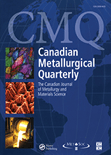
CANADIAN METALLURGICAL QUARTERLY
Championing Excellence in Metallurgical Research.Canadian Metallurgical Quarterly is a prestigious scholarly journal published by Taylor & Francis Ltd, dedicated to the field of metallurgical engineering and materials science. With a rich history dating back to its inception in 1962 and continuing through its most recent publications, this journal serves as a vital platform for the dissemination of innovative research, advancements, and critical reviews in metallurgy, metals, and alloys. Positioned strategically within the academic community, it holds a significant impact factor and is currently rated in the Q2 category for Metals and Alloys, and Q3 in Industrial and Manufacturing Engineering as of 2023, showcasing its authoritative role in these disciplines. Although it does not offer open access, the journal remains widely recognized for its rigorous peer-review process, ensuring that published work adheres to the highest standards of scientific quality. Researchers, professionals, and students alike will find invaluable insights and contributions that drive the field forward.

CORROSION ENGINEERING SCIENCE AND TECHNOLOGY
Innovating solutions to combat corrosion challenges.CORROSION ENGINEERING SCIENCE AND TECHNOLOGY is a pivotal journal dedicated to the exploration and advancement of corrosion knowledge and technologies, published by SAGE Publications Inc. This esteemed journal holds an ISSN of 1478-422X and an E-ISSN of 1743-2782, and is available for access in the United Kingdom and beyond. With a converged timeline from 2003 to 2024, it continues to publish high-quality research, fostering innovation in the fields of Chemical Engineering, Chemistry, and Materials Science, currently ranked in the Q3 quartile in these categories as of 2023. Additionally, the journal's Scopus rankings—211th in General Chemistry, 145th in General Chemical Engineering, and 266th in General Materials Science—underscore its commitment to disseminating impactful research. As an open-access journal, it invites researchers, professionals, and students to engage with cutting-edge developments in corrosion science, offering insights and solutions critical to numerous industries and enhancing collective academic understanding.

Metals
Shaping the future of materials science through rigorous research.Metals is an esteemed open access journal published by MDPI, focusing on the diverse field of metallurgical science and its applications. Since its inception in 2011, the journal has provided a platform for the dissemination of high-quality research regarding the behavior, processing, and properties of metals and alloys. With an E-ISSN of 2075-4701, it has quickly established itself within the scientific community, achieving a remarkable Q1 ranking in the realm of Metals and Alloys and a Q2 rank in general Materials Science as of 2023. The journal is situated in Switzerland and is committed to the principles of open access, ensuring that findings are accessible to a broad audience without subscription barriers. With its notable impact factor and a strong emphasis on innovative research, Metals serves as an essential resource for researchers, professionals, and students seeking to advance their knowledge and understanding in the ever-evolving landscape of metallurgical studies.
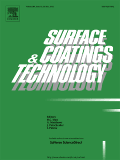
SURFACE & COATINGS TECHNOLOGY
Unveiling the Science Behind Surfaces and CoatingsSURFACE & COATINGS TECHNOLOGY is a premier academic journal that has been at the forefront of research and innovation since its inception in 1986, diligently published by Elsevier Science SA. With an impressive range of studies focusing on surface and coatings technologies, the journal has established itself as a leading platform within the fields of Chemistry, Condensed Matter Physics, and Materials Science. Notably, it holds a distinguished Q1 ranking in multiple categories, showcasing its relevance and high impact in the academic community. Furthermore, it is recognized for its rigorous peer-review process and is indexed in esteemed databases, maintaining its strong position with a ranking of #17 in Surfaces, Coatings, and Films. Although the journal does not currently offer open access options, it continues to be a crucial resource for researchers, professionals, and students seeking insights into cutting-edge developments and applications in the domain of surface engineering. With a commitment to advancing knowledge across these disciplines, SURFACE & COATINGS TECHNOLOGY is an essential read for anyone interested in the latest trends and technologies shaping the industry.

International Journal of Electrochemical Science
Empowering researchers to shape the future of electrochemistry.International Journal of Electrochemical Science is a peer-reviewed journal dedicated to disseminating cutting-edge research in the field of electrochemistry. Published by Elsevier in Serbia, this journal serves as a vital platform for scientists and researchers to explore innovative electrochemical techniques, processes, and applications. With an ISSN of 1452-3981, it has been a respected source of scholarly articles since its inception in 2006 and continues to bridge the gap between theoretical advancements and practical implementations up until 2024. Notably, it holds a Q4 quartile ranking in the field of electrochemistry and ranks 41 out of 60 in the Scopus database, situating it within the 32nd percentile among its peers. The journal champions open academic discourse, contributing significantly to the advancement of knowledge in electrochemical sciences, making it an essential resource for researchers, professionals, and students alike who are striving towards new discoveries and innovations.
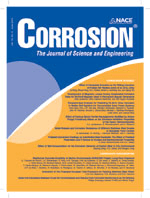
CORROSION
Advancing the Science of Corrosion ManagementCORROSION is a prestigious journal published by the Natal Association of Corrosion Engineers, dedicated to advancing the understanding of corrosion phenomena in various materials across multiple industries. With a strong commitment to high-quality research, it has established itself as a key resource in the fields of Chemical Engineering, Chemistry, and Materials Science, as reflected in its Q3 ranking in the 2023 category quartiles. This journal, retaining its relevance since 1969, serves as a platform for innovative studies and findings that address fundamental and applied aspects of corrosion, vital for professionals engaged in material selection and integrity management. Through access to state-of-the-art research, CORROSION significantly contributes to the safety, sustainability, and efficiency of engineering practices worldwide. Researchers, professionals, and students alike can benefit from the insights offered by this journal, driving forward the quest for innovative solutions in corrosion management.

Protection of Metals and Physical Chemistry of Surfaces
Advancing Knowledge in Surface Chemistry and Metal ProtectionProtection of Metals and Physical Chemistry of Surfaces is a prominent academic journal published by MAIK NAUKA/INTERPERIODICA/SPRINGER, which provides a specialized platform for researchers and professionals in the fields of materials chemistry, metals and alloys, organic chemistry, as well as surfaces, coatings, and films. With an ISSN of 2070-2051 and an E-ISSN of 2070-206X, the journal is recognized for its rigorous peer-reviewed content and comprehensive coverage of innovative research addressing the latest advancements in material protection and surface chemistry. As of 2023, the journal has been categorized in the Q3 quartile across several relevant fields, highlighting its increasing influence within the scientific community. Although the journal is relatively niche, its open access model encourages wide dissemination of knowledge, fostering collaboration and advancements within its core disciplines. Research published in this journal plays a crucial role in not only enhancing theoretical understanding but also facilitating practical applications in various industries, thereby underlining its importance for students, researchers, and professionals alike.
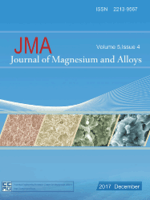
Journal of Magnesium and Alloys
Unlocking the Potential of Magnesium AlloysThe Journal of Magnesium and Alloys is a prestigious, peer-reviewed academic publication dedicated to advancing the field of materials science, particularly focusing on magnesium and its alloys. Published by KEAI PUBLISHING LTD since 2013, this Open Access journal enables unrestricted dissemination of research findings, enhancing global collaboration among researchers, professionals, and students. With an ISSN of 2213-9567 and a significant impact factor, it has established itself in the upper quartiles (Q1) of both the Mechanics of Materials and Metals and Alloys categories, ranking #3 out of 176 and #9 out of 398 respectively according to Scopus. The journal aims to provide a forum for the latest advances in the understanding, production, and application of magnesium alloys, fostering innovation and sustainable practices within the materials engineering community. Based in Beijing, China, the journal is committed to bridging gaps in current knowledge and driving future research directions through its high-quality publications.